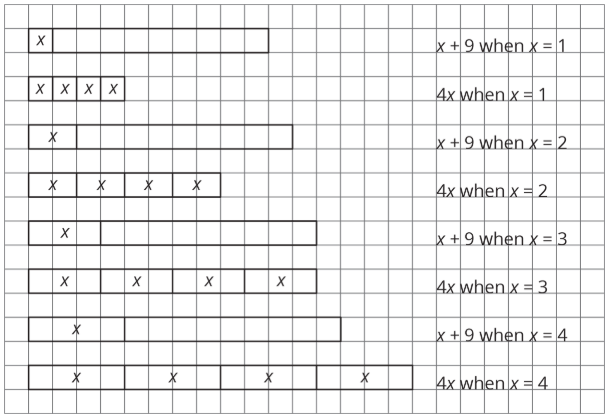32.3: Equal and Equivalent
- Page ID
- 40609
Lesson
Let's use diagrams to figure out which expressions are equivalent and which are just sometimes equal.
Exercise \(\PageIndex{1}\): Algebra Talk: Solving Equations by Seeing Structure
Find a solution to each equation mentally.
\(3+x=8\)
\(10=12-x\)
\(x^{2}=49\)
\(\frac{1}{3}x=6\)
Exercise \(\PageIndex{2}\): Using Diagrams to Show That Expressions are Equivalent
Here is a diagram of \(x+2\) and \(3x\) when \(x\) is \(4\). Notice that the two diagrams are lined up on their left sides.

In each of your drawings below, line up the diagrams on one side.
- Draw a diagram of \(x+2\), and a separate diagram of \(3x\), when \(x\) is \(3\).

- Draw a diagram of \(x+2\), and a separate diagram of \(3x\), when \(x\) is \(2\).

- Draw a diagram of \(x+2\), and a separate diagram of \(3x\), when \(x\) is \(1\).

- Draw a diagram of \(x+2\), and a separate diagram of \(3x\), when \(x\) is \(0\).

- When are \(x+2\) and \(3x\) equal? When are they not equal? Use your diagrams to explain.
- Draw a diagram of \(x+3\), and a separate diagram of \(3+x\).
- When are \(x+3\) and \(3+x\) equal? When are they not equal? Use your diagrams to explain.
Exercise \(\PageIndex{3}\): Identifying Equivalent Expressions
Here is a list of expressions. Find any pairs of expressions that are equivalent. If you get stuck, try reasoning with diagrams.
\(\begin{array}{lllllllll}{a+3}&{\qquad}&{a\div\frac{1}{3}}&{\qquad}&{\frac{1}{3}a}&{\qquad}&{\frac{a}{3}}&{\qquad}&{a}\\{a+a+a}&{\qquad}&{a\cdot 3}&{\qquad}&{3a}&{\qquad}&{1a}&{\qquad}&{3+a}\end{array}\)
Are you ready for more?
Below are four questions about equivalent expressions. For each one:
- Decide whether you think the expressions are equivalent.
- Test your guess by choosing numbers for \(x\) (and \(y\), if needed).
- Are \(\frac{x\cdot x\cdot x\cdot x}{x}\) and \(x\cdot x\cdot x\) equivalent expressions?
- Are \(\frac{x+x+x+x}{x}\) and \(x+x+x\) equivalent expressions?
- Are \(2(x+y)\) and \(2x+2y\) equivalent expressions?
- Are \(2xy\) and \(2x\cdot 2y\) equivalent expressions?
Summary
We can use diagrams showing lengths of rectangles to see when expressions are equal. For example, the expressions \(x+9\) and \(4x\) are equal when \(x\) is \(3\), but are not equal for other values of \(x\).

Sometimes two expressions are equal for only one particular value of their variable. Other times, they seem to be equal no matter what the value of the variable.
Expressions that are always equal for the same value of their variable are called equivalent expressions. However, it would be impossible to test every possible value of the variable. How can we know for sure that expressions are equivalent? We use the meaning of operations and properties of operations to know that expressions are equivalent. Here are some examples:
- \(x+3\) is equivalent to \(3+x\) because of the commutative property of addition.
- \(4\cdot y\) is equivalent to \(y\cdot 4\) because of the commutative property of multiplication.
- \(a+a+a+a+a\) is equivalent to \(5\cdot a\) because adding 5 copies of something is the same as multiplying it by 5.
- \(b\div 3\) is equivalent to \(b\cdot\frac{1}{3}\) because dividing by a number is the same as multiplying by its reciprocal.
In the coming lessons, we will see how another property, the distributive property, can show that expressions are equivalent.
Glossary Entries
Definition: Equivalent Expressions
Equivalent expressions are always equal to each other. If the expressions have variables, they are equal whenever the same value is used for the variable in each expression.
For example, \(3x+4x\) is equivalent to \(5x+2x\). No matter what value we use for \(x\), these expressions are always equal. When \(x\) is 3, both expressions equal 21. When \(x\) is 10, both expressions equal 70.
Practice
Exercise \(\PageIndex{4}\)
- Draw a diagram of \(x+3\) and a diagram of \(2x\) when \(x\) is \(1\).

- Draw a diagram of \(x+3\) and of \(2x\) when \(x\) is \(2\).

- Draw a diagram of \(x+3\) and of \(2x\) when \(x\) is \(3\).

- Draw a diagram of \(x+3\) and of \(2x\) when \(x\) is \(4\).

- When are \(x+3\) and \(2x\) equal? When are they not equal? Use your diagrams to explain.
Exercise \(\PageIndex{5}\)
- Do \(4x\) and \(15+x\) have the same value when \(x\) is \(5\)?
- Are \(4x\) and \(15+x\) equivalent expressions? Explain your reasoning.
Exercise \(\PageIndex{6}\)
- Check that \(2b+b\) and \(3b\) have the same value when \(b\) is 1, 2, and 3.
- Do \(2b+b\) and \(3b\) have the same value for all values of \(b\)? Explain your reasoning.
- Are \(2b+b\) and \(3b\) equivalent expressions?
Exercise \(\PageIndex{7}\)
80% of \(x\) is equal to 100.
- Write an equation that shows the relationship of 80%, \(x\), and 100.
- Use your equation to find \(x\).
(From Unit 6.2.2)
Exercise \(\PageIndex{8}\)
For each story problem, write an equation to represent the problem and then solve the equation. Be sure to explain the meaning of any variables you use.
- Jada’s dog was \(5\frac{1}{2}\) inches tall when it was a puppy. Now her dog is \(14\frac{1}{2}\) inches taller than that. How tall is Jada’s dog now?
- Lin picked \(9\frac{3}{4}\) pounds of apples, which was 3 times the weight of the apples Andre picked. How many pounds of apples did Andre pick?
(From Unit 6.1.5)
Exercise \(\PageIndex{9}\)
Find these products.
- \((2.3)\cdot (1.4)\)
- \((1.72)\cdot (2.6)\)
- \((18.2)\cdot (0.2)\)
- \(15\cdot (1.2)\)
(From Unit 5.3.4)
Exercise \(\PageIndex{10}\)
Calculate \(141.75\div 2.5\) using a method of your choice. Show or explain your reasoning.
(From Unit 5.4.5)

